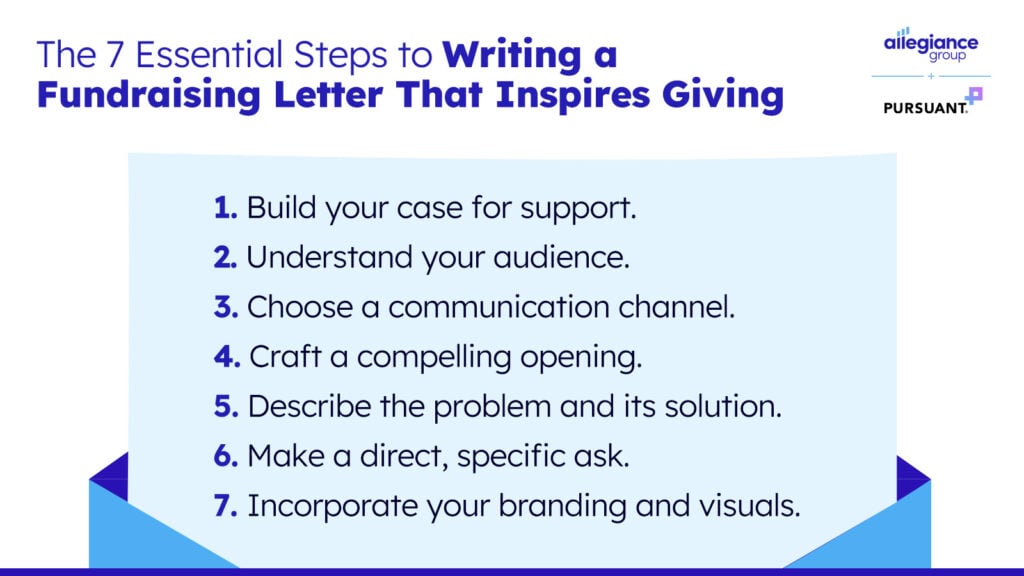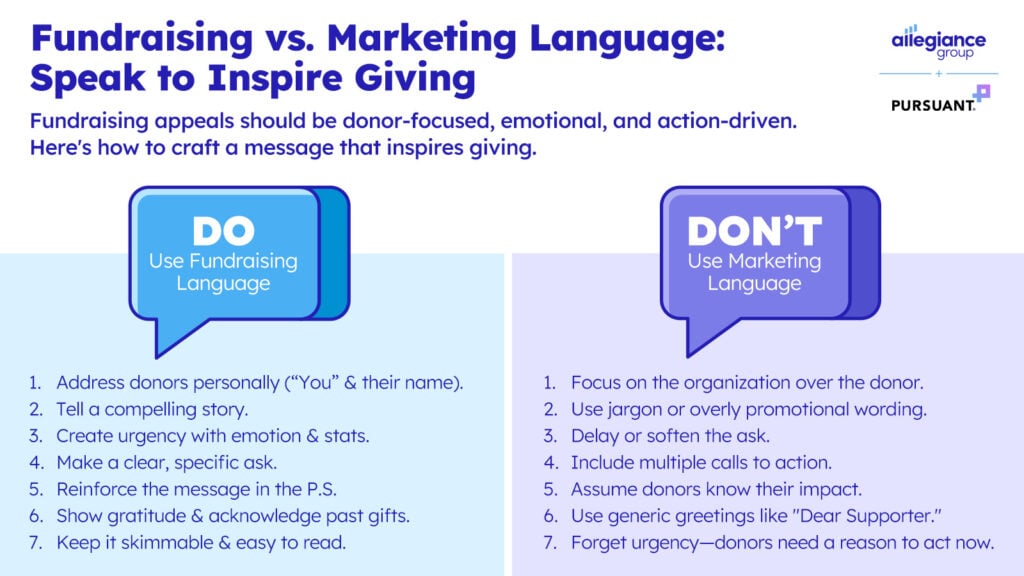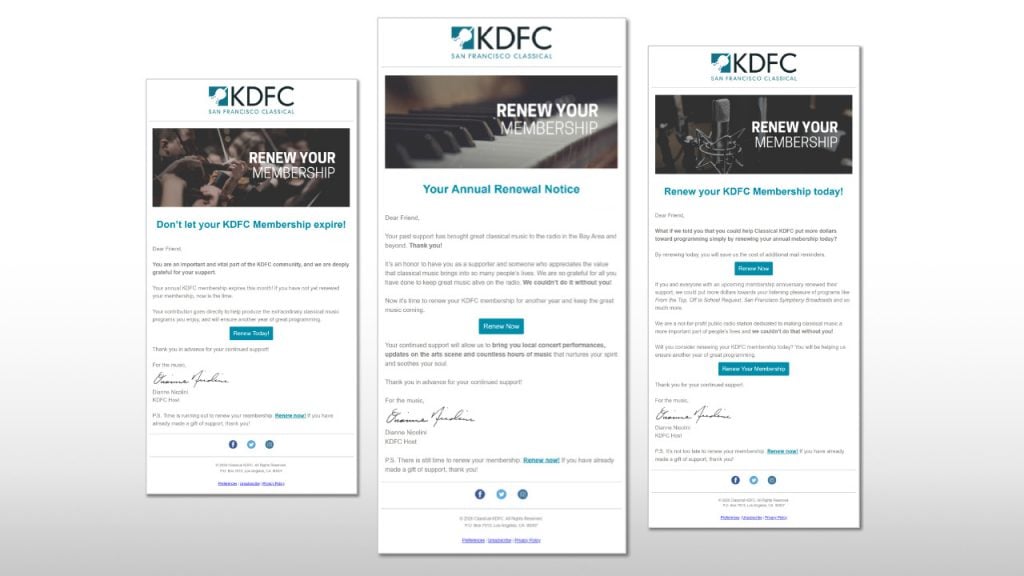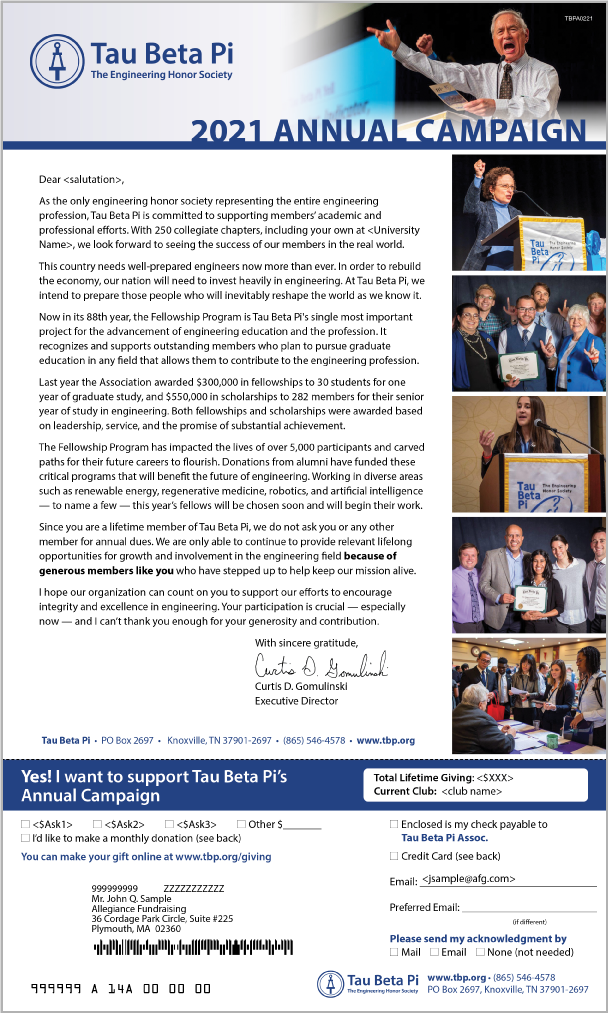How to Write an Engaging Direct Mail Fundraising Letter

How often have you asked yourself, “How can my organization improve its fundraising campaign results?” One answer to this critical question is: Evaluate the strength of your appeal copy, specifically the direct mail and email appeals targeted to individual donors. Direct mail fundraising letters are more personal than other methods. You can make a direct appeal, communicate impact and even educate the reader about the cause.
Direct mail appeal remains a foundational part of many nonprofits fundraising efforts and serves as an important to foster relationships with donors. In this guide, we walk you through how to write a compelling fundraising letter.
See impressive results that drive impact when you leverage Allegiance Group + Pursuant’s professional direct mail fundraising services.
6 Key Components of Effective Direct Mail Appeals
When evaluating your copy, remember these key components of a powerful, engaging fundraising letter:
- Build a case for support. This core message helps prospective donors understand why they should give money to your organization and the impact it has.
- Use an emotional and personal tone (one-on-one conversational). Write directly to the donor and share a human story behind the mission.
- Write for the skimmer. Ask early in the appeal and repeat the ask multiple times. Keep to your core message without unnecessary detail.
- Urgency in your call to action. Use words like “urgent,” “now,” and “today.” You can include a deadline.
- Say thank you. Acknowledge donors’ generosity and express your heartfelt appreciation for their support.
- “You” language makes the donor the hero. It’s about how the donor is making a difference – not just what the organization is doing. Showcase their support.
How to Write a Fundraising Letter in 7 Steps

1. Build your case for support.
As you build your case for support, make sure you answer these three key questions:
- Why give? To answer this question, share a story about how their gift is used that connects with donors on an emotional level.
- Why give now? Explain what donors will miss if they don’t give. Your donors know another campaign is coming eventually so if your appeal doesn’t clearly state “why now,” it’s more likely to hit the trash or recycle bin. Donors give because they enjoy the feeling of being part of making a difference or being rewarded with a premium.
- What’s the consequence of not giving? Be clear what happens if they don’t give.
A professional copywriter can bring clarity if you need help answering these three questions. Our Allegiance Group + Pursuant copywriters will often interview clients to get to know them better and home in on the case for giving. Copywriting services are a core part of our direct mail offerings.
2. Understand your audience.
A successful nonprofit fundraising letter involves understanding your audience. This involves research and analysis of:
- Existing donors and past campaigns. To understand how your donors give, review your giving habits, social media followers, event attendees, and most dedicated ambassadors and volunteers. Assess which campaigns were successful and why and donors’ preferred communication channels.
- Market landscape. Look to identify trends and unique appeals that set your organization apart. Analyze geographic markets to understand awareness and affinity for your nonprofit in specific regions.
- Peer organizations. Evaluating peer organizations can help identify your strengths and weaknesses and uncover ways to differentiate your organization.
This research will help you identify clear key audiences and help you outline specific focus areas to craft your direct mail appeal. Without this kind of insight, you risk wasting resources and potentially missing out on opportunities by not appealing to supporters’ unique interests and motivations.
3. Choose a communication channel.
When deciding on a communication channel, keep your supporters’ preferences top of mind.
Email appeals are quick, inexpensive, and allows for easy personalization and segmentation. It also allows for real-time engagement, tailored follow up and response.
Direct mail (physical letter) can feel more real and inspiring, plus they have a longer shelf life. Letters can build trust and credibility while reaching diverse audiences, specifically those that prefer traditional communication methods.
Organizations can use multiple channels – coordinated mail and email appeals that tell the same story – but you will need to adapt the letter based on what you choose. A few key differences exist between a fundraising letter and an email appeal.
For example, a well-designed physical letter would look like a wall of text when put into an email frame, while emails must pack a punch in fewer words — only the essentials — to be effective. Direct mail needs a scannable QR code, but an email can include clickable links, donation buttons, graphics or a video to break up text.

4. Craft a compelling opening.
Remember, fundraising language is donor-focused so use a personal voice and open the letter by greeting the donor by name. The first couple of sentences are the most important as they will determine whether the supporter continues to read. Connect the reader with your mission.
Here are some strategies to consider:
- Make a powerful opening statement.
- Lead with statistics
- Ask a question
- Tell a story about a beneficiary
5. Describe the problem and its solution.
Quickly describe the problem or the reason their donation is needed. Don’t wait to mention it. Here are a few strategies you may find useful:
- Convey a sense of urgency
- Storytelling
- Use statistics
Explain how their gift can remedy or at least help alleviate the problem. The donor should feel like their donation will make a tangible difference in someone’s life. People decide to give by listening to their hearts.
When considering how long your letter should be, write for the skimmer. Generally, reader will look for their name, then go straight to the P.S. – the crucial section used to reinforce the main message, reiterate the call to action, or share news, like a matching gift or upcoming event.
After the P.S, readers then go up the first paragraph, scan what’s in bold and underlined (or linked if an email), then decide if they want to read the whole appeal. If you write for the skimmer and answer the three key questions above when building your case for giving, the length of your appeal becomes much less important.
6. Make a direct, specific ask.
When making the ask, be direct.
- Ask for what you need
- Don’t ask the reader to do more than one thing – stick with one clear, call to action
- Convey how the money will be used
- Preemptively express gratitude
- Consider acknowledging previous donations/engagement
Don’t make the mistake of falling back on marketing language when you’re asking for money. You need to build a case for supporting your nonprofit. Use donor-centric language. It can be emotional, urgent, and repeat the case for giving.

7. Incorporate your branding and visuals.
Enhance your case for support by integrating your branding and visuals. Consistent branding is important in a direct and organizations should include at least their name and logo to the letter – not just the outer envelope. Additionally, visuals are critical in telling the story, such as photos of a beneficiary or volunteers in action, a testimonial, graphics that help visualize impact metrics or a testimonial.
Whether an email or a print letter, these visuals break up the text and bring your message to life, making it easy for a donor to see – as well as feel – how they are making a difference.
Wrapping Up
As you finalize your direct mail appeal, pull in other team members or stakeholders to review and offer feedback. They can help identify anything from typos to missed opportunities to highlight impact. Keep this process focused and on schedule to ensure your appeal is sent on time.
Remember, nonprofits can mail letters at reduced rates with a nonprofit authorization number through the US Postal Service. There is an application process, but the savings can make a difference.
Effective Direct Mail Fundraising Letter Examples
Email Appeal

Allegiance Group + Pursuant and KDFC, a classical music station, collaborated to update their E-Renewal series, which had been experiencing a low response rate. After testing and rewriting their subject lines, refreshing their body copy and adding more prominent CTA buttons, KDFC’s updated series generated a 92 percent lift in response rate – a driving factor in achieving an 85% increase in year-on-year gross revenue.
Direct Mail Appeal

Tau Beta Pi was experiencing declining response rates and revenue from its three annual direct mail campaigns. The engineering honor society partnered with Allegiance Group + Pursuant, and by changed the focus of each appeal to one specific theme and highlighting mission-driven initiatives in each campaign which yielded improved results. The letter form design incorporated images of students engaging in conferences, attending sessions, and accepting awards. The results? The response rate increased from 3.22% to 5.37%, a 67% increase. And the gross revenue-per-piece-mailed increased from $3.69 to $5.42 – a nearly 50% increase!
Want to Take Your Appeals to the Next Level? Ask a Professional
Allegiance Group + Pursuant understands how to translate your organization’s mission and your case for giving into powerful direct mail and email appeals directed toward individual donors. We employ internal and external professional copywriters to ensure that your campaign copy is as strong as it can be and is written by an expert in your industry– whether that be public media, food banks, arts and culture organizations, or those with a focus on societal benefit.
Connect with our direct mail fundraising experts, who’ll partner with you to make the world a better place.
Direct mail fundraising remains a cornerstone for many nonprofits, fostering strong donor relationships as well as driving significant giving results. It’s an opportunity to capture a donor’s heart and drive them to action. Let us help you make those connections!
Resources:
Review direct mail case studies